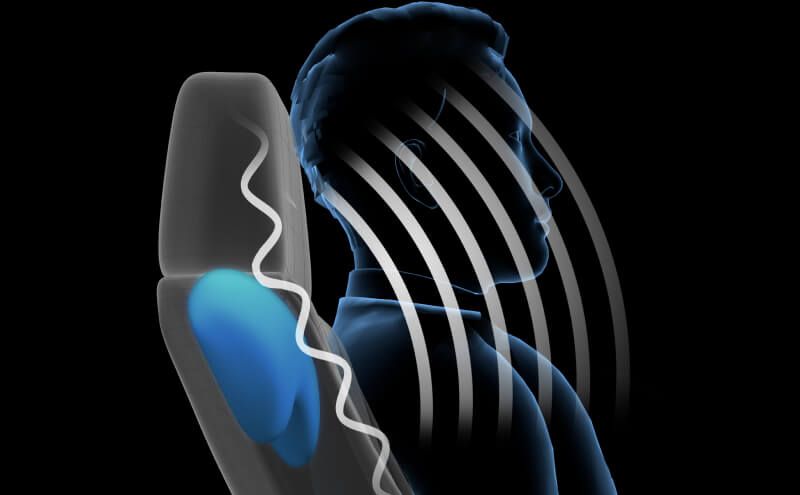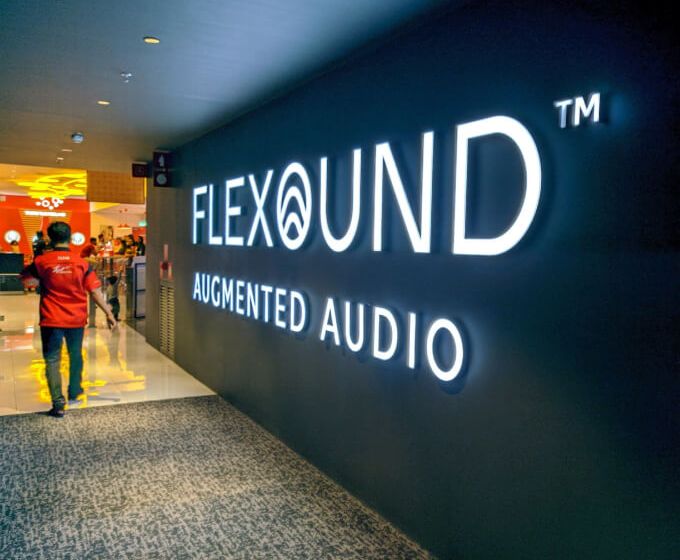
FLEXOUND Augmented Audio™ represents a leap forward in high-quality audio technology as well as the listening experience, so it naturally raises some good questions. Here are those we hear most often...
Q: How does it feel to listen to music with FLEXOUND Augmented Audio™?
A: Listening to FLEXOUND Augmented Audio™ is an enriched, multi-sensory experience that uses touch to connect you to a powerful bass beat, even at low listening volumes, while the near field audio signal allows for crystal-clear clarity throughout the full audible frequency range of 20 hertz to 20,000 hertz.
Q: What about the mid-range frequency response?
A: Most musical instruments and vocals live in the mid-range. These frequencies can be heard but also felt with FLEXOUND Augmented Audio™, in a way that they cannot with conventional far field audio, so it becomes incredibly easy to track the detail within songs.
Q: How about watching movies and streaming TV?
A: When it comes to movies and streaming, soundtracks are lent a new weight that does not rely on heavy, high-powered subwoofers and our customers consistently report that the next-level clarity delivered within their personal FLEXOUND Augmented Audio™ sound spheres allows dialogue to be heard distinctly, without having to crank up the volume.
Q: How does the core technology in FLEXOUND Augmented Audio™ work?
A: The core structure is a cushion, with a patented soundboard assembly of a vibrating soundboard, an electromagnetic driver and foam layers with high quality cover material. This creates a personal sound sphere around you, using near field audio technology.
Q: Is there much sound leakage from this personal sound sphere
A: With the FLEXOUND Pulse™ listening experience, there is minimal sound leakage, and the audio technology building the sound sphere does not necessarily require the same decibel levels because you have two senses compensating and contributing to the listening experience.
Q: Does the technology feature noise cancellation?
A: While developing the FLEXOUND Augmented Audio™ technology we have noticed an interesting effect that we are calling ‘Natural Noise Cancellation’. The sound waves created by the near field audio device that is very close to you do seem to have the effect of maintaining attention to personal immersion in sound content and cancelling out external ambient noise, beyond the effects of pure decibels.
Q: Which frequencies are you actually feeling through the sense of touch with FLEXOUND technology?
A: Interestingly, your skin’s sense of touch actually goes up to 500 Hz, and even to 1,000 Hz for your hands, so it’s not just the sub-bass frequencies you are feeling, which comes as a surprise to many people.
Q: What are the benefits compared to loudspeakers?
A: Heavy, power-hungry loudspeakers cannot engage the sense of touch in the same way because they are transmitting the audio through air only, and they need to fill a room with sound waves, losing clarity as a result due to the reverberations that then occur.
Q: What are the benefits compared to headphones?
A: FLEXOUND Augmented Audio™ liberates you from being attached to accessories, which deepens immersion. At the same time, you are more socially available and present. In terms of the sound characteristics, the soundscape is more ambient and does not turn with your head. FLEXOUND near field listening is something in between loudspeaker farfield and headphone “on-ear” sound.
Q: How loud does FLEXOUND Augmented Audio™ sound?
A: Another benefit of our technology is that by hearing through your skin as well as your ears, you don’t need as many decibels to achieve clarity and immersion. This means that you can start from a lower volume but still get high-quality, full range audio.
Q: Is it really a problem that cinemas have to use volume to create the far field soundscape?
A: Well, 6% of the world population suffers from some kind of hearing loss and amplified audio can exacerbate this. The peak decibel requirement listed by cinema operators is 95db and extends to 105db for low frequencies.
Q: How can the FLEXOUND Pulse™ replicate cinema surround sound with just a single seat?
A: FLEXOUND Pulse™ provides a personalised, enclosed equivalent of 5.1 surround sound by feeding the audio signal to four channels, each of which can reproduce high-quality full range audio, which is carefully mechanically tuned.
Q: What if you’re watching an over-the-top action movie? Would the vibration ever get too much?
A: No, because we have built the system and sophisticated signal processing to take very intense low frequency sounds and intelligently manage them for a natural experience that never becomes overwhelming. FLEXOUND Pulse™ does not shake or move itself – what you are feeling is pure sound vibration.
Q: So what would happen if I needed to hear anything above the sound of the movie?
A: Because FLEXOUND Pulse™ creates your own personal sound sphere around your body, you can simply lean forwards in your seat to reduce the decibel level and hear ambient sounds, although this works more efficiently with our backrest seats and cushions.
Q: What problems does FLEXOUND Pulse™ solve?
A: Firstly, traditional loudspeakers neglect to use a powerful and available sense to connect and interact with audio – that of touch. Secondly, they require a lot of power because at low frequencies the efficiency of transmitting vibrations to air is poor, so traditional loudspeakers need to pump out a lot of energy to get the desired effect.
Q: How do you explain the paradox of soft foam, which should insulate sound, actually conducting it in your products?
A: The reason is that the soft foam is not separate but is attached to the elastic vibrating sound boards. So, dissipation or the acoustic semiconductivity of the foam combined with the soundboards is the key to this innovation that nobody else has done.
Q: Could the FLEXOUND Pulse™ single-seat technology be expanded to create an enclosed two or three-seater experience that you could share in the home?
A: Yes, this is an obvious extension of the FLEXOUND Pulse™ solution, which delivers the pleasant and accurate soundscape experience that is the heart and core of our offering. We are exploring those future possibilities in home and office furniture.
Q: Could other applications like video conferencing become important to FLEXOUND Augmented Audio™?
A: Yes, you could see a situation where an enclosure could be used as a mobile workspace to offer enhanced video conferencing with a new level of privacy, or in education, or to provide an augmented virtual reality experience.
Q: How can FLEXOUND assist things like meditation and mindfulness?
A: The creation of a personal sound sphere provides a distraction-free zone that really helps you escape from the information flow.Hearing through touch may boost the effectiveness of mindfulness and meditation exercises that direct your attention to your body (like having focus in sensing your breathing), in order to help activate the relaxing para-sympathetic nervous system.
Q: Where does the name FLEXOUND come from?
A: Firstly, FLEXOUND reflects the character of our first cushion products targeted for therapy use – they are received by children as slightly mysterious, soft, huggable and flexible embodiments of sound. Secondly, the core innovation – an elastic soundboard with porous layers – vibrates with specific characteristics in the form of flexural waves, which distribute the sound energy in a unique way, from the sound source. Finally, FLEXOUND manifests the flexibility of our Augmented Audio solutions, which shine in many industries.
FLEXOUND Augmented Audio™ adds the sensation of touch to all audio content. The versatile and patented technology was originally created to help autistic children. It can now be embedded into seats in cinemas, cars and airplanes, gaming chairs, cushions, furniture and more.
Subscribe to our newsletter:
